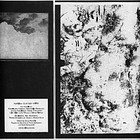Sometimes what Julian Sartorius, a Swiss percussionist with a highly acoustic approach, and Dan Nicholls, a UK-based electronic artist with an unmistakably digital mindset, create together as Clay Kin sounds like a stripped-back form of minimal techno. But more often than not, Vevey reaches a level of abstraction that contrasts starkly with the very tangible locations in which it was recorded – forests, lakes, and mountains around the eponymous Swiss town, where trickling water, rustling leaves, and passing hikers become part of the sonic material.
What Sartorius and Nicholls shape through free improvisation and spontaneous interaction resists categorisation, and may even serve as proof that disparate forms of exploratory music are tied together by invisible threads – whether that’s contemporary composition, free improvisation, or techno. Clay Kin invert the traditional relationship between rhythm and melody. Not just because Nicholls’s live sample manipulation often doubles as the percussive backbone, but because Sartorius’s multi-layered, colour-rich percussion becomes the album’s gravitational centre.


